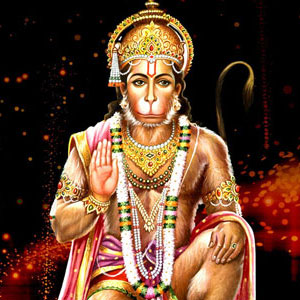
Shri Bajrangbali ji
Hanuman came to be regarded as
an avatar of Shiva by the 10th century. Hanuman is mentioned as an avatar of Shiva or Rudra
in the Sanskrit texts like Mahabhagvata Purana, Skanda Purana, Brhaddharma Purana and Mahanataka
among others. This development might have been a result of the Shavite attempts to insert their
ishta devata in the Vaishnavite texts, which were gaining popularity.
The 17th century Odia work Rasavinoda by Divakrsnadasa goes on to mention that the three
gods – Brahma, Vishnu and Shiva – combined to take to the form of Hanuman.
Hanuman became more important in the medieval period, and came to be portrayed as the ideal devotee of Rama. His characterization as a lifelong brahmachari was another important
development during
this period. The belief that Hanuman's celibacy is the source of his strength became popular
among the wrestlers in India. The celibacy or brahmacharya aspect of Hanuman is not mentioned
in the original Ramayana. In Jain texts, Hanuman is depicted as the 17th of 24 Kamadevas,
the one who is ultimately handsome.
Major Festivals
* Sri Hanuman
Jayanti (Chaitra Shukla Chaturdashi and Purnima).
* Ashwin
Shukla Chaturdashi and Purnima.
* Bhadrapad
Shukla Chaturdashi and Purnima.
* All three
of these festivals are attractive and attracts lakhs of Devotees from around the
Country
Meeting with Rama
Hanuman meets Rama during the Rama's 14-year exile. With his brother Lakshmana, Rama is searching
for his wife Sita who had been abducted by Ravana. Their search brings them to the vicinity of the
mountain Rishyamukha, where Sugriva, along with his followers and friends, are in hiding from his
older brother Vali.
Having seen Rama and Lakshmana, Sugriva sends Hanuman to ascertain their identities. Hanuman approaches the two
brothers in the guise of a brahmin. His first words to them are such that Rama says to Lakshmana that
none could speak the way the brahmin did unless he or she had mastered the Vedas. He notes that
there is no defect in the brahmin's countenance, eyes, forehead, brows, or any limb. He points out
to Lakshmana that his accent is captivating, adding that even an enemy with sword drawn would be
moved. He praises the disguised Hanuman further, saying that sure success awaited the king whose
emissaries were as accomplished as he was.
When Rama introduces himself, the brahman identitifies himself as Hanuman and falls prostrate before
Rama, who embraces him warmly. Thereafter, Hanuman's life becomes interwoven with that of Rama.
Hanuman then brings about friendship and alliance between Rama and Sugriva; Rama helps Sugriva
regain his honour and makes him king of Kishkindha. Sugriva and his vanaras, most notably Hanuman,
help Rama defeat Raavana and reunite with Sita.
In their search for Sita, a group of Vanaras reaches the southern seashore. Upon encountering the
vast ocean, every vanara begins to lament his inability to jump across the water. Hanuman too is
saddened at the possible failure of his mission, until the other vanaras and the wise bear
Jambavantha begin to extol his virtues. Hanuman then recollects his own powers, enlarges his body,
and flies across the ocean. On his way, he encounters a mountain that rises from the sea, proclaims
that it owed his father a debt, and asks him to rest a while before proceeding. Not wanting to
waste any time, Hanuman thanks the mountain, touches it briefly, and presses on. He then
encounters a goddess disguised as a sea-monster, Surasa, who challenges him to enter her mouth.
When Hanuman outwits her, she admits that her challenge was merely a test of his courage.
After killing Simhika, a rakshasi, he reaches Lanka.